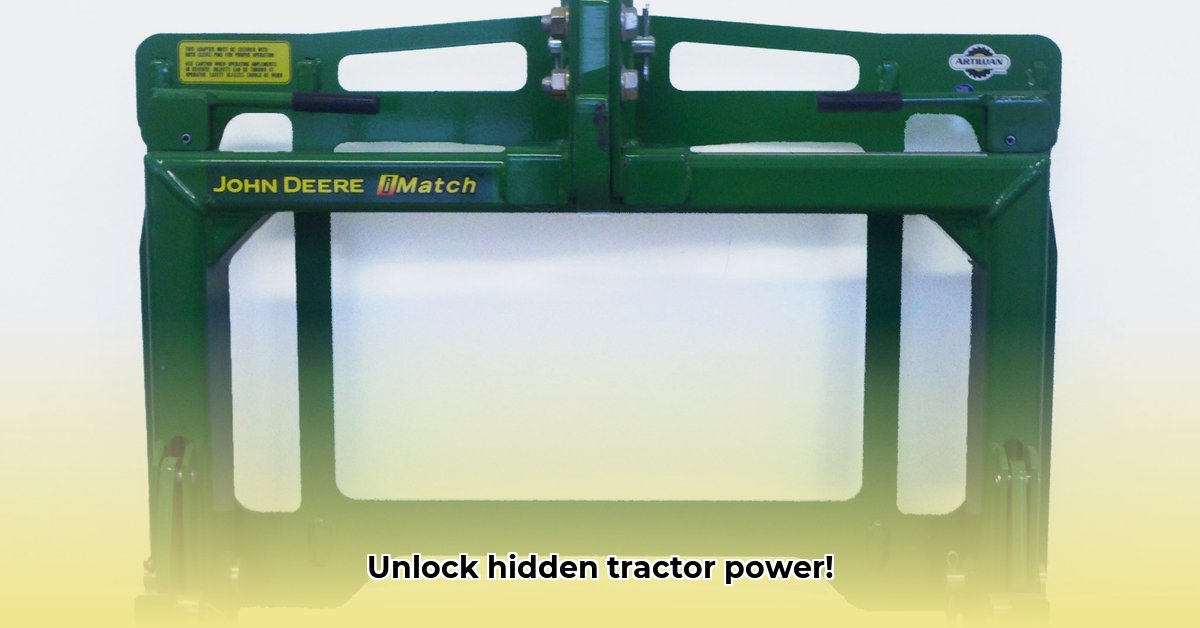
Selecting the Right Hitch Adapter for Your Needs
Choosing the right tractor hitch adapter is paramount for efficient and sustainable farming. The wrong choice can lead to reduced efficiency, increased wear and tear on your equipment, and even damage to your soil. This section outlines the key factors to consider when selecting an adapter for your specific needs. For more information on hitch adapters, visit this helpful resource.
Tractor Compatibility: Begin by consulting your tractor's owner's manual. This document specifies the weight limits and hitch type your tractor can safely support. Exceeding these limits is dangerous and can cause serious damage. Remember, safety should always be your top priority.
Implement Compatibility: Consider the implements you regularly use. Light tools like a seed drill require a less robust adapter than heavy-duty equipment such as a plow. Heavier implements demand more durable and powerful adapters. A mismatch can result in reduced efficiency and even equipment failure.
Quick-Attach Systems: For farmers frequently switching implements, quick-attach systems offer significant time savings. These systems enable fast and easy changes, minimizing downtime and fuel consumption. However, quick-attach systems are generally suited for lighter implements.
Material Considerations: Steel adapters are strong and durable but heavier. Aluminum adapters are lighter, potentially improving fuel efficiency and reducing soil compaction. However, aluminum might have reduced durability depending on the usage. Dr. Emily Carter, Agricultural Engineer at Purdue University, notes that "aluminum offers a compelling weight advantage in many applications, but long-term durability needs further study across various soil types and workloads." The best material choice depends on your specific circumstances and priorities.
Cost-Benefit Analysis: Factor the cost into your decision-making process. While a more robust adapter might cost more upfront, its extended lifespan and reduced maintenance needs may result in long-term savings. Weigh the initial investment against the potential benefits of increased efficiency and reduced downtime. Don't forget to factor in potential fuel savings associated with lighter materials.
Installing Your Hitch Adapter Safely and Efficiently
Correct installation is vital for both your safety and the longevity of your equipment. Improper installation can lead to accidents or equipment damage. Always refer to both your adapter and tractor manuals before beginning.
- Safety First: Engage your tractor’s parking brake before proceeding with any installation or adjustment. This prevents accidents. Failure to do so could result in serious injury.
- Precise Alignment: Carefully align the hitch adapter with your tractor's hitch points. Even minor misalignment can cause problems.
- Secure Connections: Securely fasten all connections. Double-check them before continuing. Loose connections can be detrimental to the lifespan of your Hitch adapter.
- Lowering the Implement: Slowly lower the connected implement to avoid sudden drops that could damage the equipment.
- Functional Check: Before beginning work, perform a test run to check for any issues.
Maintaining Your Hitch Adapter for Optimal Performance
Regular maintenance is essential for extending the life of your hitch adapter and ensuring its continued efficiency.
- Post-Use Inspection: After each use, inspect your adapter for wear or damage, including bent pins or loose connections. Addressing small issues promptly prevents them from becoming major problems.
- Lubrication: Lubricate moving parts according to the manufacturer's recommendations. This reduces friction and prolongs the adapter's lifespan.
- Tightening Bolts: Regularly check and tighten loose bolts or connections to maintain a safe and secure fit.
- Storage: Store your hitch adapter in a dry, covered location when not in use to prevent rust and corrosion. This simple precaution significantly extends its lifespan.
Troubleshooting Common Hitch Adapter Problems
Even with proper care, issues can arise. The following table highlights some common problems and potential solutions:
| Problem | Potential Solutions |
|---|---|
| Adapter won't connect | Check alignment, ensure pins are seated, and lubricate moving parts |
| Implement slips during use | Verify connections are tight, inspect for wear and tear on adapter parts |
| Adapter fails to disengage | Follow the disengagement procedure outlined in your manuals. |
| Unusual noise during operation | Check for loose parts, wear, or damage; excessive noise often indicates a problem needing repair. |
Fuel Efficiency and Soil Health: The Sustainable Advantages
Using the right hitch adapter directly contributes to both fuel efficiency and soil health. Quick-attach systems, for example, significantly reduce downtime, thus saving fuel. Minimizing soil compaction is also vital for maintaining long-term soil health. This contributes to increased yields over time. Professor David Johnson, Soil Scientist at Iowa State University, notes that "reduced compaction leads to improved water infiltration, better nutrient uptake, and increased microbial activity, ultimately enhancing soil health and long-term productivity."
Environmental Impact: Considering Sustainable Materials and Practices
The materials used in hitch adapters – steel versus aluminum – have environmental implications. Steel is durable, but aluminum, while potentially less durable in some applications, offers fuel efficiency benefits due to its lighter weight. The overall environmental impact depends on factors like manufacturing processes, lifespan, and end-of-life recycling. A lifecycle assessment is needed for a conclusive comparison between the two materials. Choosing sustainable materials and practices contributes to a healthier environment.
Three Pivotal Points:
- Selecting the correct hitch adapter is crucial for efficient and sustainable farming practices.
- Proper installation and maintenance extend the lifespan of the adapter and prevent costly repairs.
- Minimizing soil compaction through careful adapter usage contributes to enhanced soil health and increased crop yields.